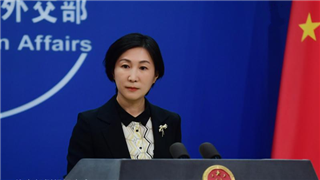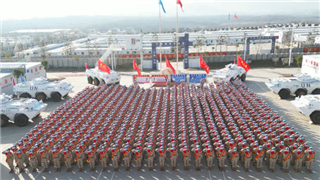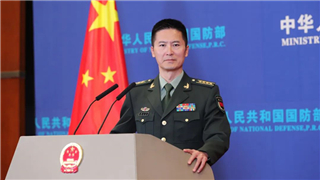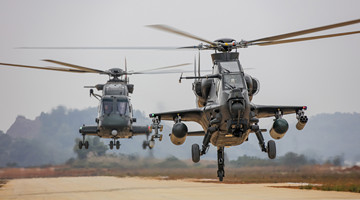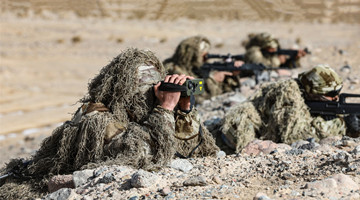By Guo Xiaobing
The US Department of Defense recently released its annual China Military Power Report, which says China currently has 400 nuclear warheads, which will increase to 1,000 in 2030 and 1,500 in 2035. To fabricate the so-called “China threat” as an excuse to ask Congress for more military budget, the DoD has cooked up this lie-strewn report based on hearsay and wild imagination without mentioning where the data came from. This typical stunt of a thief crying “stop thief” is aimed at covering up the following disgraceful actions in the area of nuclear arms control and non-proliferation.
The US is keeping an ultra-low threshold of using nuclear weapons for integrated deterrence. Washington has expanded the scope of its nuclear deterrence to cope with non-nuclear strategic threats from space and the cyber domain during Trump’s term. Its newly released Nuclear Posture Review report drums about integrated deterrence instead of using such terms as “non-first use” and “sole purpose”, which means the country will use nuclear weapons to not only deter nuclear attacks but also other strategic attacks. That will further blur the boundary between nuclear and conventional forces, and intensify the coordination between nuclear and non-nuclear programs, exercises, and actions.
The US is detailing customized deterrence and getting ready to fight two nuclear wars, including the limited-scale one. The US claims that by 2030, it will for the first time in history face a situation when two major nuclear states will be its strategic competitors and potential rivals, and it’s prepared to fight on both sides. “In a potential conflict with a competitor, the United States would need to be able to deter opportunistic aggression by another competitor… recognizing that a near-simultaneous conflict with two nuclear-armed states would constitute an extreme circumstance.” Therefore, the Biden administration has further detailed the nuclear deterrence strategy customized by the Trump administration to target China and Russia.
The US has extended deterrence by reinforcing the “Indo-Pacific” nuclear sharing mechanism and the forward deployment of strategic forces. The US military intends to strengthen the consultation with its Indo-Pacific allies on extended deterrence by discussing nuclear deterrence policies, sharing strategic intelligence, and strengthening bloc cooperation. For that purpose, it will form a US-Japan-ROK or US-Japan-ROK-Australia information sharing and dialogue mechanism, thus duplicating the NATO-like nuclear alliance in the West Pacific. The US will also deploy strategic bombers, dual-purpose warplanes and nuclear weapons in the “Indo-Pacific” to highlight its presence.
The US keeps updating its nuclear arsenal. The latest Nuclear Posture Review has abandoned the Obama administration’s commitment to not producing new types of nuclear warheads but continued to promote the nuclear Triad. On the land, the intercontinental ballistic missile Sentinel will replace the Minuteman III on schedule to become the new-generation land-based deterrence force. On the sea, the Columbia-class strategic nuclear submarine will replace the Ohio-class counterpart in 2030. In the air, the B-21 strategic bomber Raider will replace B-2A, while F-35A fighters, carrying nuclear warheads, will also take the place of F-15E gradually to carry out NATO’s nuclear missions.
The US’ development and deployment of low-yield nuclear warheads increase the risk of nuclear conflict. To prepare for limited-scale nuclear warfare, the Trump administration suggested putting the low-yield warhead W76-2 on submarine-launched ballistic missiles and sea-based cruise missiles. The Democratic Party said in its 2020 campaigning program that W76-2 is unnecessary, but the new Nuclear Posture Review supports its production and continued use on submarine-launched ballistic missiles.
The US is practicing double standards in proliferating weapon-grade fission materials. The US and the UK plan to transfer to Australia under the AUKUS framework nuclear submarines that carry enough highly enriched uranium to make 60-80 nuclear warheads, which essentially constitutes an act of nuclear proliferation. The three countries have also been stalling a report to relevant agencies on the substantive progress of their nuclear submarine cooperation on the grounds that they haven’t determined the cooperation plan yet.
America’s development of nuclear forces based on a narrow perspective of major-country competition while hyping up the imagination-fueled “China nuclear threat” is in no way good for the stable development of China-US relations, particularly nuclear relations.
(The author is Director of the Center for Arms Control Studies, China Institutes of Contemporary International Relations)
Editor's note: Originally published on china.com.cn, this article is translated from Chinese into English and edited by the China Military Online. The information and opinions in this article do not necessarily reflect the views of eng.chinamil.com.cn.
